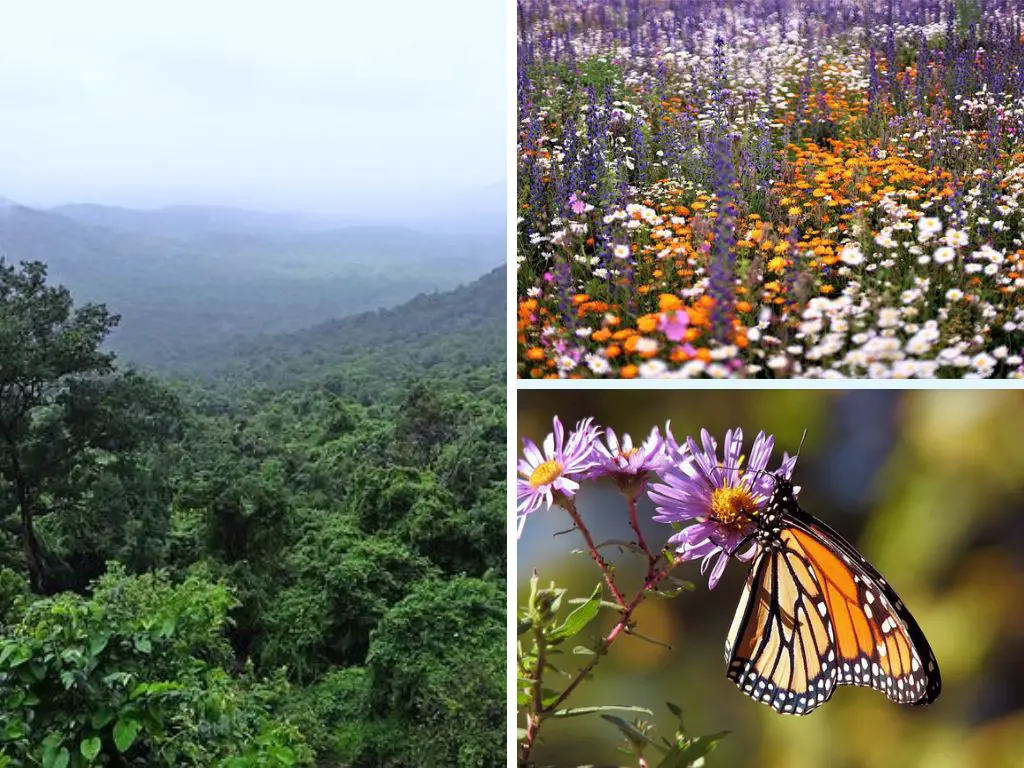In this guide, we discuss some of the important aspects of biodiversity.
We provide a definition of what it is, along with outlining why biodiversity might be important, and give examples of environments that might be more biodiverse than others.
What Is Biodiversity? (A Definition)
Biodiversity might be described or defined as the variety of life or living things.
It can be described spatially (i.e. worldwide, or in a specific geographic habitat or environment), and also over a certain time period.
It includes living things such as animals, plants, and microorganisms.
Within biodiversity as a whole, there’s also specific types of diversity that can be measured, such as species diversity, genetic diversity (which measures the range of genetic material & information), and also ecosystem diversity.
On a local scale, regional biodiversity measures how diverse a specific region or area of the world is.
Why Is Biodiversity Important? Why Should We Conserve It?
Biodiversity might be considered important because of the flow-on effect it has on the environment and society
Biodiverse environments are also important to humans for social and economic reasons
Flow On Effect Of Biodiversity
The flow on effect might look something like this:
– Biodiversity supports and contributes to healthy ecosystems, and ecosystems that can perform their functions effectively
– Ecosystems provide a number of services to the environment and wildlife
Examples might include providing a habitat (on land, in freshwater and in the ocean), cleaning/purifying water (which aquatic wildlife live in, and other wildlife make contact with or drink from), and contributing to healthy and fertile soils (which soil based organisms live in)
– Humans rely on healthy ecosystems that can carry out different functions and services
For example, biodiverse environments might be better for pollination, climate regulation, diseases regulation, erosion regulation, and water purification (qld.gov.au lists some other functions and services that biodiverse environments might provide)
Humans extract fresh water from the environment, use the soil (especially productive soil for agriculture), fish from healthy sea life populations (especially fish populations), and extract various raw materials and natural resources from it
Other Specific Reasons Biodiversity Might Be Important
– Environmental Reasons
Biodiverse environments might contribute to healthier environments and ecosystems for plant life, animals and microorganisms
– Economic Reasons
Biodiverse environments such as tropical rainforests, reefs, savannas and wetlands might contribute a significant amount of revenue and economic value to the economy
As a few examples …
The raw materials and ingredients of many products we use are extracted from rainforests, along with other resources. Rainforests are also used for tourism
The raw materials and ingredients of some products we use are extracted from coral reefs, along with other resources. Coral reefs are also used for tourism and recreational activities like snorkelling and diving
Healthier marine environments, and biodiverse oceans can contribute to healthier and sustainable fishing populations, which is better for the fishing industry
Wetlands can be used as productive agricultural land
Savannas contribute economically through revenue generated through the wildlife industry (and wildlife tourism), agriculture and the timber industry
– Social Reasons
The economic benefits of biodiverse environments leads to better employment and income opportunities
There’s also groups of people whose social values align with environmentalism and conserving biodiversity
– Cultural Reasons
Some local cultures place significant importance on biodiverse environments
– Specific Resources That May Come From Biodiverse Ecosystems & Environments
Food (such as seafood)
Fibres
Fuel
Biochemicals
Materials that comes from trees and regular forest plantations
Limestone and construction materials that are derived from some coral reefs
Freshwater
Specific Services That Biodiverse Environments Might Provide
qld.gov.au provides a list of services that biodiverse environments might provide, such as provisioning services, cultural services, supporting services, regulating services, and biodiscovery
Types Of Biodiversity
Three of the main types of biodiversity might be:
– Terrestrial Biodiversity
Biodiversity on the land
– Freshwater Biodiversity
Biodiversity in freshwater sources such as rivers and lakes
– Marine Biodiversity
Biodiversity in the seas, oceans, and on coastlines
Examples Of Biodiversity
Some of the most biodiverse places on Earth might be:
Other places on Earth with more biodiversity than other areas might be:
– Wetlands (the listed wikipedia.org resource discusses the importance and biodiversity of the world’s wetlands in more detail)
– Savannas
pugetsound.edu makes a point about how some environments and ecosystems might be diverse in one way, but not as much in another.
For example, they mention that:
Savannas are quite low in tree species diversity because of stringent ecological requirements but fairly high in diversity of herbaceous plants …
Animal diversity is fairly high, although much lower overall than tropical forested areas …
Biodiversity Loss
We put together a separate guide where we outline what biodiversity loss is, and discuss some of the important aspects of it.
Sources
1. Various ‘Better Meets Reality’ guides
2. https://www.qld.gov.au/environment/plants-animals/biodiversity/about
3. https://news.mongabay.com/2016/08/savannas-and-grasslands-are-more-biodiverse-than-you-might-think-and-were-not-doing-enough-to-conserve-them/
4. https://www2.pugetsound.edu/academics/academic-resources/slater-museum/biodiversity-resources/world-biomes/characteristics-of-bioclimatic/savanna/
5. https://en.wikipedia.org/wiki/Resource_depletion
6. https://en.wikipedia.org/wiki/Biodiversity
','' ); } ?>